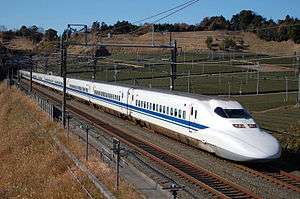Asahi (train)
|
200 series on an Asahi service in Tokyo, August 2002 | |
| Overview | |
|---|---|
| Service type | Shinkansen |
| Locale | Jōetsu Shinkansen |
| First service |
1960 (Semi-express) 1982 (Shinkansen) |
| Last service | 30 November 2002 |
| Successor | Toki |
| Current operator(s) | JR East |
| Former operator(s) | JNR |
| Route | |
| Start | Tokyo |
| End | Niigata |
| On-board services | |
| Class(es) | Standard + Green |
| Catering facilities | Trolley service |
| Technical | |
| Rolling stock | 200 series, E1 series, E4 series |
| Track gauge | 1,435 mm (4 ft 8 1⁄2 in) |
| Electrification | 25 kV AC overhead |
| Operating speed | 275 km/h (170 mph) |
The Asahi (あさひ) was a limited-stop train service that operated until November 2002 in Japan on the Jōetsu Shinkansen between Tokyo and Niigata.[1]
Operations
The Asahi shinkansen services ran approximately hourly, with two down services (Asahi 1 and 3) permitted to operate at 275 km/h in the tunnel section between Jōmō-Kōgen and Urasa using specially modified 200 series (F90) sets, completing the journey in 1 hour 40 minutes (compared to the fastest journey time of 1 hour 37 minutes in 2008 for Toki services operating at a maximum speed of 240 km/h).[2][3]
Rolling stock

- 200 series 10/12-car sets (November 1982–November 2002)
- E1 series 12-car sets, as Max Asahi (July 1994–November 2002)
- E2 series 8-car sets (December 1998–November 2002)
- E4 series 8-car sets, as Max Asahi (May 2001–November 2002)
History
The name Asahi, meaning "morning sun" in Japanese, was first introduced on 1 November 1960 for semi-express (準急 junkyū) services operating between Niigata and Sendai. This service was renamed Benibana from 1 July 1982.[2]
From the start of services on the newly opened Jōetsu Shinkansen on 15 November 1982, Asahi was the name used for the limited-stop shinkansen services operating initially between Ōmiya and Niigata, later between Ueno and Niigata, and eventually between Tokyo and Niigata.[2] At the start of Jōetsu Shinkansen operations in 1982, 11 Asahi services operated in each direction daily. With the start of shinkansen operations from Ueno on 14 March 1985, the number of Asahi services was increased to 34 in each direction daily. From 10 March 1990, two down services (nicknamed Super Asahi) were timed to operate at a maximum speed of 275 km/h in the tunnel section between Jōmō-Kōgen and Urasa. New E1 series "Max" 12-car sets were introduced on Max Asahi services from 15 July 1994, with two workings in each direction daily between Tokyo and Niigata. The number of Max Asahi services was increased to five in each direction daily from 3 December 1994.[4] E4 series "Max" trains built in 1997 were first assigned to Max Asahi services on 7 May 2001.[5]
The Asahi name was discontinued from 1 December 2002 when the Toki name was re-introduced for all Tokyo to Niigata trains.[1]
See also
References
| Wikimedia Commons has media related to Asahi. |
- 1 2 JR新幹線&特急列車ファイル [JR Shinkansen & Limited Express Train File]. Japan: Kōtsū Shimbun. 2008. p. 22. ISBN 978-4-330-00608-6.
- 1 2 3 列車名鑑1995 [Train Name Directory 1995]. Japan: Railway Journal. August 1995.
- ↑ JR Timetable, December 2008
- ↑ "JR特急 10年の歩み" (10 years of JR Limited Expresses), published May 1997 by Kousai Shuppansha
- ↑ Yamanouchi, Shūichirō (2002). 東北・上越新幹線 [Tōhoku & Jōetsu Shinkansen]. Tokyo, Japan: JTB Can Books. ISBN 4-533-04513-8.





.svg.png)